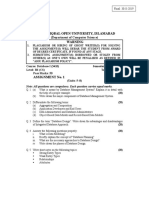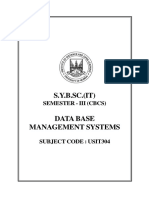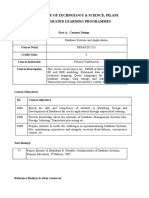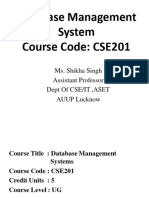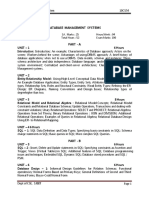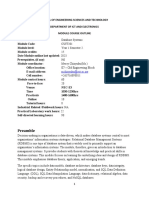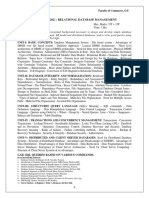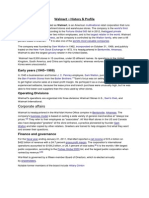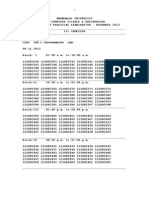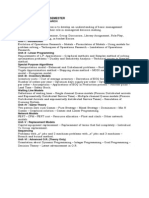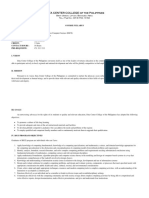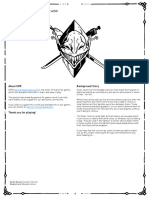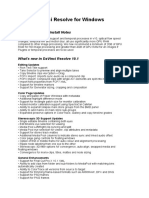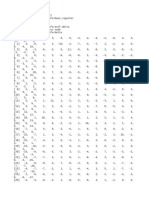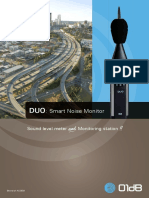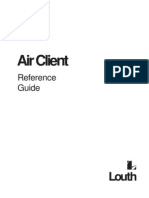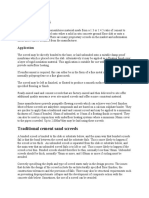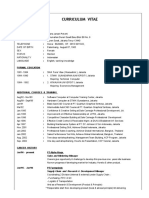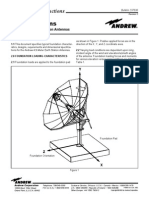8XX08C RDBMS (Oracle and DB2) AIM: To study the basic concepts of database systems, relational database and
queries, object modeling and database design. UNIT I Database and Database management Systems: Introduction-History of Database Management Systems- Characteristics of DBMS- Meaning and Definition of Databaseobjectives of database- advantages of database and disadvantages of traditional file environment systems- meaning and definition of Database Management Systems [DBMS]- Designing Databases-Hierarchical Data model- Network Data model- and Relational Data models-Database trends: Distributed Databases- data warehousing- and data mining- Object-oriented hypermedia Databases- linking databases to the web. UNIT II Relational Database [RDBMS]: The Relational Database Model-TechniquesComponents of Relational Model- Definition of Relational Terms- Features of RDBMSCODD 12 rules for a fully RDBMS. Relational implementation Primary and Foreign Keys- Relationships in the relational model Introduction to ER Model- one-to-one, oneto- many, many to many relationship- Examples of Data definition language. UNIT III Queries - Maintaining Integrity-Defining Data Integrity- Integrity Rules- Relational Integrity Rules- Referential Integrity- Entity Integrity- Domain Integrity- Entity IntegrityUser-defined Integrity- Integrity Constraints- Domain Constraints- Normalisation Benefits of normalization- Functional Dependency and Determinants- Normalisation Theory- -Review of Normal Forms-Structured Language Query [SQL]- Characteristics of SQL. Types of SQL [DCL- DDl- DML]- Basic queries in SQL Single table- Multi tableRetrievals- Nested queries - Deletion- Insertion- and Update in SQL. UNIT IV Object Modeling and Database Design: Introduction- Types of Data Models (ConceptualLogical and Physical Data modeling)- Model Development-Attributes of Modeling-ER model- the object-oriented model- record based models- physical data models- Stages of Data modeling- Modeling Three Schema Architecture- Entity Relationship [ER] modelEntities Attributes and Relation [EAR] models- Entity Relationship Diagrams- Other
�Styles of ER Diagram- The Data Dictionary- Transforming from Logical to PhysicalStorage Structure types- Sorting and Indexes- Pointer chains- Advantages & Disadvantages of Pointer Chains- Sorting Data in a file- Necessity of files- Working parts of a DBMS- File Formats- Fixed Format Files- File Processing Activities- File organization & Methods- Clustered Indexes- Non Clustered Indexes- Covering IndexesIndex Selection. UNIT V Database Design: - Selecting your data- normalization- identifying domains- naming standards- denormalisation and the rules of reconstruction- physical design of databasesrule of reconstruction- over normalization- Reverse Engineering of Databases. TEXT BOOK: 1. Silberschatz Korth Sudarshan Data Base System Concepts, 4th Edition Published by Tata McGraw Hill Publishing Company REFERENCES: 1. Alexis Leon & C.K. Thomas DB2 (IBM Database 2), The Complete Book for Application Programmers, Comdex Computer Publication a division of Pustak Mahal. 2. Er. V. K. Jain, DATABASE MANAGEMENT SYSTEMS,Dreamtech press, New Delhi. 3. Prof. S. Nandagopalan, Database Management Systems, A Practical Approach, Sapna Book House, Bangalore. 4. James Martin, Principles of Database Management, Prentice Hall of India New Delhi.

